|

“The King seems to radiate a powerful authority”
Your function as King in a game of Chess is to snatch lighting from the sky and the scepter from the opposing King. The two Kings have a special role in a contest, since the object
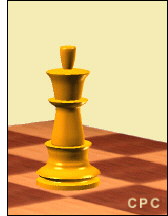 as
laid down in the rules, is the pursuit and checkmate of
the enemy King. If you capture all your opponent’s
pieces and the King still remains at large then you have
not won the game. The King must at all costs be
protected from attack. Capture of the other pieces may
only be a means to facilitate the final chase and
submission of the opposing King. The King may move one
cell forward, backward, or laterally (sideways). He may
capture any one of your opponent’s pieces which stand on
an adjoining cell to what which he occupies, provided
that the piece has been left unprotected. Said piece is
to be removed from the board. The King has the peculiar
privilege of being exempt from this indignity
(capture). Your King is not permitted to move into check, that is, onto any cell
or square
which is guarded by a piece of your opponent. The
King may not be moved to a cell adjacent to that on
which the rival King is stationed. If placed in
block of cells A, B, or C on a vacant board he may
move to any of the eight different cells or squares surrounding
him. If placed on the side of the board, he
may move to any of five different cells or squares. If placed in
the corners of the board, three cells or squares are at his
command only. as
laid down in the rules, is the pursuit and checkmate of
the enemy King. If you capture all your opponent’s
pieces and the King still remains at large then you have
not won the game. The King must at all costs be
protected from attack. Capture of the other pieces may
only be a means to facilitate the final chase and
submission of the opposing King. The King may move one
cell forward, backward, or laterally (sideways). He may
capture any one of your opponent’s pieces which stand on
an adjoining cell to what which he occupies, provided
that the piece has been left unprotected. Said piece is
to be removed from the board. The King has the peculiar
privilege of being exempt from this indignity
(capture). Your King is not permitted to move into check, that is, onto any cell
or square
which is guarded by a piece of your opponent. The
King may not be moved to a cell adjacent to that on
which the rival King is stationed. If placed in
block of cells A, B, or C on a vacant board he may
move to any of the eight different cells or squares surrounding
him. If placed on the side of the board, he
may move to any of five different cells or squares. If placed in
the corners of the board, three cells or squares are at his
command only.
“The
King never dies”
A King is usually described as a male sovereign or
monarch, who holds by life tenure the chief authority
over a country and people. The King regards his subjects as his children and admonishes his administrators to observe gentleness in dealing with them. The King seems to radiate a powerful authority and a strange intensity of feeling, characteristic of statuary art. He sits on his throne with his face radiating both authority and love - a haunting beauty - his majestic presence inspiring awe and a sense of mystery.
“Punctuality is the politeness of Kings”
The King is one of the major pieces in the game of Chess
moving one cell in any direction and is known under
different names in differing countries -see table below. The
King in the 13th century was allowed to make a leap, but
only once in a game, and from this idea the castling
move evolved. You must try to keep your King safe at all
times as the aim of the game is to capture the enemy’s
King. The King is known by different names in differing countries:
Chess piece names in
other languages
|
Language |
Piece name |
Game
name |
|
English |
King |
Chess |
|
French |
Roi |
Les echecs |
|
German |
König |
Schachspiel |
|
Italian |
Re |
Gli scacchi |
|
Spanish |
Rey |
Ajedrez |
|
Portuguese |
Rei |
Xadrez |
|
Russian |
Korol' |
Shahmati |
|
Arabic |
Shah |
Ash-shatranj |
|
Latin |
Scacus |
Scaci |
“That the King can do no wrong, is a necessary and
fundamental principle of the English Constitution”
At the beginning of a game it is best to move His Majesty to the side of the board by castling. If left in the center he is exposed to assault as the rest of your pieces are developed. He is strongest in the endgame when there are few major and/or minor pieces remaining and can help checkmate the opponent’s King or even win pieces. Your King can only move one cell per move and so has no attacking power during the early part of the game.
“Lit De Justice”
The cell on which the King resides. French: the sofa upon which the King of France sat when holding formal sessions of parliament. A game of Chess/session. The King plays two parts in the game, while he is usually passive at first, later he frequently assumes an active role. In fact, in the endgame the King often has great influence as an active major piece.
In the middle of the board he controls eight cells, all those in his immediate vicinity, and this is mainly useful in protecting his own pieces and attacking your opponents.
In the middle game it is above all the passive function of the King that is predominant. The danger of checkmate not only nearly always prevents him from taking part in the struggle with the enemy pieces but often even compels his own pieces to give him care and protection.
Cases where the King supports the other pieces in attack are extremely rare in the middle game. It is much commoner in the middle game for the King’s qualities to be turned to advantage in defense, in the protection of his own major and minor pieces.
If a major piece attacks your King, try to interpose a piece that attacks the checking piece if possible. Try to check the opposing King and oblige him to move, thus depriving your
adversary’s King of the right to castle (this is considered good play).
Sometimes you can give a sequence of checks or even sacrifice a major piece, to force the King into the middle of
the rank-8, where the King can be attacked by your other pieces. In the endgame phase, your King should be busily engaged and used to compensate for his previous inactivity. The result of a game may depend on your skill in managing the King
in the endgame.
“Soon there will be only five Kings left:
the King of England, the King of
spades, the King of clubs,
the King of hearts and the King of diamonds”
During the Middle Ages the word “Scacus” was used for King but, during later periods scacus was used for any of the Chess pieces and its plural
“Scaci” was used to denote the game of traditional Chess itself. The French retain the plural form
“Les Echecs”, and the Italians “Gli Scacchi”. In Ancient Mesopotamia kingship was said to have come from heaven - the King's position was given by the gods and his principal duty is to serve them. As mediators between gods and people King's have an important place and many religious obligations, including the building and maintenance of temples.
The King was originally called “Rey” and his movement very restricted (not being allowed to move at all except for the necessity of extricating himself from
check/+). In the 13th century he was allowed to move one cell forward but not permitted to move or capture diagonally. Eventually he was allowed to move and capture one cell in any direction which is the way he moves today. The King’s range has never extended beyond one cell.
In old India, the King in Chess was called ksh, and that he connects the words meaning to Kush. Also, the Indians called the squares of the
chessboard ksh-tagara, which means granary [Kings granary?], or fertility squares (connection with fertility and especially with Venus, in all of her various forms). The Mayan name for our sun is Kinich Ahau ksh = kinich. The Mayan names for the pieces are given below: (from Goddess web page)
Mayan piece
names
|
Chess pieces |
Mayan names |
Meaning |
|
King |
Ahau |
Yellow Sun |
|
Queen |
Lamat |
Yellow Star |
|
Warrior |
Cib |
Yellow Warrior |
|
Counselor |
Ix |
White Wizard |
|
Pawn |
Eb |
Yellow Human |
|
Rook |
Ben |
Red Skywalker |
|
Knight |
Akbal |
Blue Night |
|
Bishop |
Kan |
Yellow Seed |
You are not permitted to commit suicide in Chess: your King must get out of check when your opponent has designs on the King’s life. It is customary in a social setting to announce check, but if you do not do so, the check is still on just the same, and your opponent must extricate him/herself immediately. There are three possible ways of getting out of check:
01. Capturing the checking piece.
02. Moving your King to a cell where he is no longer in
check.
03. Interposing a piece between the King and the checking piece: an interposition.
(This third scenario is not available when a Knight checks the King.).
If none of the above are available, it is checkmate, which the player announces (avoiding a triumphant tone). This ends the game. A King may never move into check. A King can never move into a cell next to the enemy King. If a King is left in check for even one move, that move and all subsequent moves are void. If the previous position cannot be restored, the whole game is replayed (this highlights the point of making an accurate record of the moves being made during a game).
Historical notes
The King was a piece that already appeared in the first variant of Chess: Chaturanga. Its movement nowadays is still the same as it was about one and a half millenniums ago, except for some fine details: castling did not originally exist in the form it is known now. For instance, in the middle ages, sometimes the King could make a Kings leap, which did not involve a Rook.
In antiquity, the King was called Shah (Arabic for King). The term checkmate comes from shah mat (Arabic for the
King is dead). The King is referred to as General in Xiangqi, or as
jeweled General in Shogi.
Movement and capture
Kings move (with or without taking) one square in an arbitrary direction. Kings are royal: they may not be moved to a square attacked by a piece of the opponent. When they are attacked by a piece of the opponent, it is called check, and when in a check that cannot be removed, they are mated, and the game is lost for their owner.
|
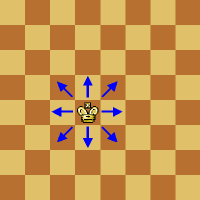
|
|
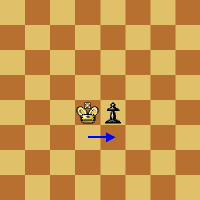
|
| |
|
|
|
This diagram shows you how the King
moves. It moves just one square at a time, in any direction:
up,
down, left, right or diagonally.
|
|
|
|
The King can capture an enemy piece
on the next square. Here, the King captures the Pawn
on e4 and is removed from the board.
|
|
|
 |
|
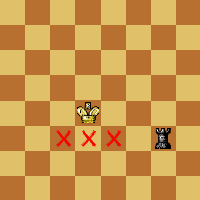 |
| |
|
|
|
On this diagram, the
white King
cannot move next to the black King.
The two
Kings can
never stand
close next to each other. |
|
|
|
The King can't
stay on or move to a square where it can be taken by an enemy
piece such as the three
squares guarded by the Rook.
|
|
|
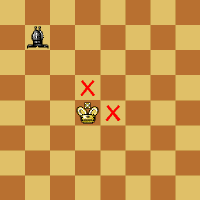 |
|
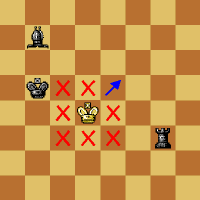 |
| |
|
|
|
In this position, the King cannot
move to a square where it could be captured or attacked by
the Bishop or any other
enemy piece. |
|
|
|
In this
situation, the King can only move to one square: e5. On every
other square, it could be taken by one of the black enemy
pieces. |
|
|
Notes: for more information on the usual Chess King, see Chesmayne
illustrated rules of Chess or the FIDE laws of Chess.
In Chaturanga the King moves as usual King, but additionally has the right to make one Knight-move during the game, provided that he has not been checked before he makes his Knight-move. Castling doesn’t exist (invented in the middle ages).
In Shatranj the King moves as usual King, but may not castle.
In Xiangqi the King may not leave the palace (the central 3 x 3 area), and also may not move into the same file (column) as the opposing King unless there are interposing pieces.
King graphics
|